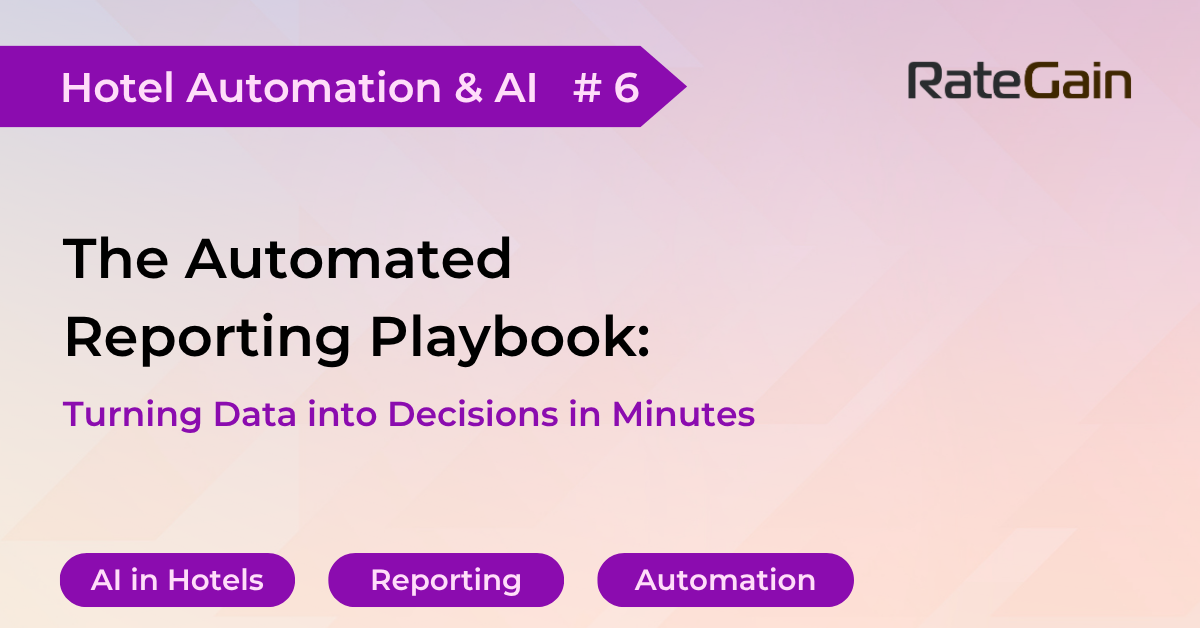Every revenue manager knows the ritual: export yesterday’s pickup, copy it into a master workbook, update the pivot table, then pray the formulas still reference the right range. Consultant Leigh Silkunas captures the waste perfectly: “Most hotels still lose three to four days every month just pulling reports.”
Fresh findings in State of Distribution 2025—compiled by HEDNA, NYU SPS Tisch Center, and RateGain—reveal the scale of the grind:
- Four in five hotels sacrifice one to two work-days every week assembling spreadsheets instead of acting on them.
- 53 percent have dipped a toe into preset dashboards, yet only 15 percent enjoy fully automated reporting.
- A mere 6 percent run enterprise BI tools like Looker or Tableau, confirming that “hotel analytics” is still mostly Excel.
This playbook shows how any property can move from manual chaos to live dashboards in 30 days while freeing up precious team bandwidth.
Why Are Spreadsheets Still Ruling Hotel Analytics?
Excel grew popular because it was free, flexible, and already on every laptop. Yet the very traits that made it a quick win now hold hotels back:
- Siloed data: Rates, reservations, and web analytics live in separate files, so decision-makers never see a true, cross-channel view.
- Stale numbers: By the time a weekly workbook is ready, parity gaps or booking surges are ancient history.
- Hidden labor cost: Four reporting days a month equals 480 staff hours a year—roughly the salary of a junior analyst.
When RevPAR growth is flat, you can hardly afford to burn whole work-weeks on chores the cloud can handle in minutes.
What Should a Modern Hotel Analytics Platform Deliver?
Great dashboards do more than look pretty. They answer the questions commercial teams ask every morning:
| Question Hotel Teams Ask | Analytics Feature That Answers It | Benefit |
|---|---|---|
| “Which channels delivered the cheapest revenue yesterday?” | Real-time channel-mix table that refreshes hourly. | Faster marketing reallocations. |
| “Did the new package cannibalize BAR (Best Available Rate)?” | Rate-plan pickup widget fed by the PMS API. | Rapid promo tuning. |
| “Is the OTA price gap still >3 percent?” | Parity alert tile integrated with your crawler. | Immediate revenue protection. |
| “Are we pacing ahead or behind last year?” | Pickup-vs-Last Year chart with drill-downs by segment. | Dynamic pricing moves. |
A true hotel-analytics layer centralizes data, refreshes automatically, visualizes KPIs in one URL, and lets power users build ad-hoc views without breaking anything.
How Can You Migrate From Excel to Live Dashboards in 30 Days?
Goal: cut manual report prep by at least 50 percent within one month.
Days 0–7 | Audit & Connect
- Inventory every file your team touches weekly.
- Map each metric to its source system—PMS, RMS, CRS, Google Analytics, or web scrubber.
- Deploy connectors (or a simple ETL like Fivetran/Airbyte) so data lands in a cloud warehouse overnight.
Days 8–14 | Prototype & Iterate
- Build a Daily Pickup & Channel Mix board in Looker, Tableau, or Power BI.
- Use stakeholder feedback sessions to refine filters, date selectors, and visual types.
- Launch a pilot to two power users; adjust based on real-world questions they can (or cannot) answer.
Days 15–21 | Automate Distribution
- Schedule an 8 a.m. email that links to the live dashboard—no CSVs attached.
- Set up role-based views so sales, marketing, and revenue each land on the metrics that matter.
- Turn off old macros and lock legacy sheets to read-only.
Days 22–30 | Retire Legacy & Measure
- Archive obsolete workbooks in a “cold storage” folder—visible but untouchable.
- Track prep time: if analysts spend over two hours in Excel, find out why.
- Aim for a ≥50 percent reduction in manual hours; many hotels hit 70 percent by week four.
What Cultural Shifts Make Dashboards Stick?
- Run a 15-minute “data huddle” every morning: Review the live board instead of emailing attachments.
- Reward insights, not creation: Praise the analyst who calls out a pricing opportunity, not the one who merged CSVs at 11 p.m.
- Document definitions: A shared KPI glossary prevents disputes over “net ADR” or “pickup.”
- Invest in micro-training: Even a one-hour Looker crash course can turn skeptics into advocates.
Frequently Asked Questions
1. Do I need a data warehouse?
Not to start. Most BI tools can query directly from your cloud PMS and RMS; warehouse later for scale.
2. How much does a BI license cost?
Cloud tiers start around USD 10–12 per user per month—often less than Excel’s hidden labor bill.
3. Will dashboards slow if I add parity or comp-set data?
Not if your connectors stream deltas rather than full reloads; look for tools with incremental refresh.
4. What about data security?
Choose platforms with role-based access, audit logs, and SOC 2 compliance to satisfy brand and GDPR checks.
Next Step: Benchmark Your Reporting Maturity
Curious how your reporting effort stacks up to peers? Download State of Distribution 2025 to see how hotels of every size automate hotel analytics, slash prep time, and convert data into real-time decisions.
 Deutsch
Deutsch Português
Português Italiano
Italiano Espanol
Espanol čeština
čeština ไทย
ไทย العربية
العربية Français
Français



